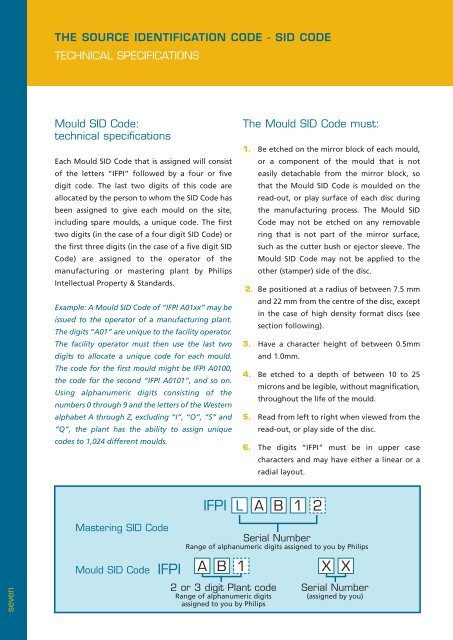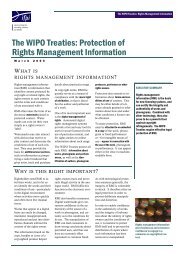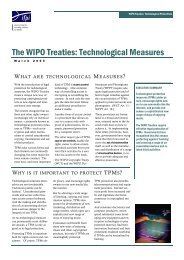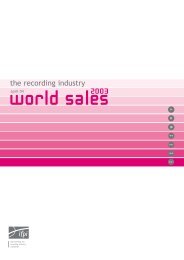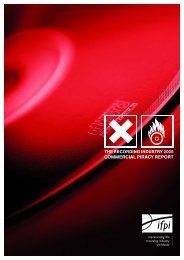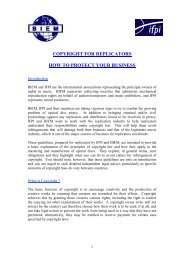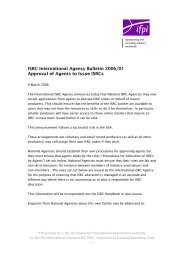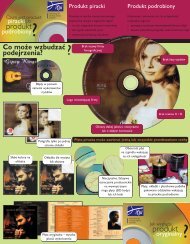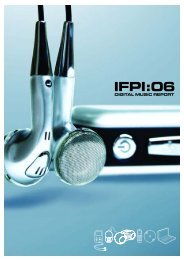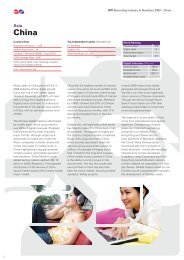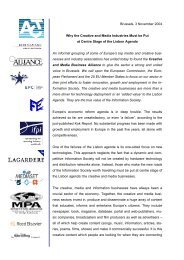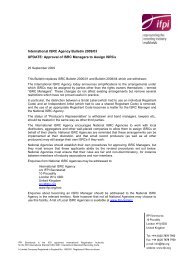SID CODE implementation guide - IFPI
SID CODE implementation guide - IFPI
SID CODE implementation guide - IFPI
Create successful ePaper yourself
Turn your PDF publications into a flip-book with our unique Google optimized e-Paper software.
THE SOURCE IDENTIFICATION <strong>CODE</strong> - <strong>SID</strong> <strong>CODE</strong><br />
TECHNICAL SPECIFICATIONS<br />
Mould <strong>SID</strong> Code:<br />
technical specifications<br />
Each Mould <strong>SID</strong> Code that is assigned will consist<br />
of the letters “<strong>IFPI</strong>” followed by a four or five<br />
digit code. The last two digits of this code are<br />
allocated by the person to whom the <strong>SID</strong> Code has<br />
been assigned to give each mould on the site,<br />
including spare moulds, a unique code. The first<br />
two digits (in the case of a four digit <strong>SID</strong> Code) or<br />
the first three digits (in the case of a five digit <strong>SID</strong><br />
Code) are assigned to the operator of the<br />
manufacturing or mastering plant by Philips<br />
Intellectual Property & Standards.<br />
Example: A Mould <strong>SID</strong> Code of “<strong>IFPI</strong> A01xx” may be<br />
issued to the operator of a manufacturing plant.<br />
The digits “A01” are unique to the facility operator.<br />
The facility operator must then use the last two<br />
digits to allocate a unique code for each mould.<br />
The code for the first mould might be <strong>IFPI</strong> A0100,<br />
the code for the second “<strong>IFPI</strong> A0101”, and so on.<br />
Using alphanumeric digits consisting of the<br />
numbers 0 through 9 and the letters of the Western<br />
alphabet A through Z, excluding “I”, “O”, “S” and<br />
“Q”, the plant has the ability to assign unique<br />
codes to 1,024 different moulds.<br />
The Mould <strong>SID</strong> Code must:<br />
1. Be etched on the mirror block of each mould,<br />
or a component of the mould that is not<br />
easily detachable from the mirror block, so<br />
that the Mould <strong>SID</strong> Code is moulded on the<br />
read-out, or play surface of each disc during<br />
the manufacturing process. The Mould <strong>SID</strong><br />
Code may not be etched on any removable<br />
ring that is not part of the mirror surface,<br />
such as the cutter bush or ejector sleeve. The<br />
Mould <strong>SID</strong> Code may not be applied to the<br />
other (stamper) side of the disc.<br />
2. Be positioned at a radius of between 7.5 mm<br />
and 22 mm from the centre of the disc, except<br />
in the case of high density format discs (see<br />
section following).<br />
3. Have a character height of between 0.5mm<br />
and 1.0mm.<br />
4. Be etched to a depth of between 10 to 25<br />
microns and be legible, without magnification,<br />
throughout the life of the mould.<br />
5. Read from left to right when viewed from the<br />
read-out, or play side of the disc.<br />
6. The digits “<strong>IFPI</strong>” must be in upper case<br />
characters and may have either a linear or a<br />
radial layout.<br />
“xx” represents the two variable digits to be assigned by the facility operator.<br />
<strong>IFPI</strong> L A B 1 2<br />
seven<br />
Mastering <strong>SID</strong> Code<br />
Serial Number<br />
Range of alphanumeric digits assigned to you by Philips<br />
Mould <strong>SID</strong> Code <strong>IFPI</strong> A B 1 X X<br />
2 or 3 digit Plant code<br />
Range of alphanumeric digits<br />
assigned to you by Philips<br />
Serial Number<br />
(assigned by you)


